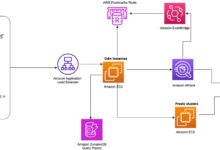AWS Console: 7 Powerful Tips to Master the Ultimate Cloud Control
Unlock the full potential of your cloud experience with the AWS Console—your gateway to seamless cloud management, powerful tools, and real-time control over Amazon’s vast ecosystem. Whether you’re a beginner or a pro, mastering this dashboard is essential.
What Is the AWS Console and Why It Matters

The AWS Console, officially known as the Amazon Web Services Management Console, is a web-based user interface that allows users to interact with AWS services. It provides a visual, point-and-click environment for managing cloud resources such as EC2 instances, S3 buckets, Lambda functions, and more. Unlike command-line tools or APIs, the AWS Console simplifies cloud operations for users who prefer a graphical interface.
Core Purpose of the AWS Console
The primary goal of the AWS Console is to make cloud computing accessible. It enables developers, system administrators, and business teams to deploy, monitor, and manage AWS resources without needing deep coding expertise. From launching virtual servers to configuring security groups, everything can be done through an intuitive dashboard.
- Provides a centralized hub for all AWS services
- Supports real-time monitoring and alerts
- Enables quick troubleshooting and diagnostics
Who Uses the AWS Console?
Different roles within an organization use the AWS Console for various purposes. Developers use it to deploy applications, DevOps engineers monitor infrastructure health, security teams audit access logs, and finance teams track spending via AWS Cost Explorer. According to AWS’s official documentation, over 80% of AWS users interact with the console daily.
“The AWS Console is the front door to the cloud—simple for beginners, powerful for experts.” — AWS Training & Certification Team
How to Access and Navigate the AWS Console
Getting started with the AWS Console is straightforward. All you need is an AWS account. Once registered, you can log in at https://console.aws.amazon.com. After logging in, you’ll be greeted by a personalized dashboard showing recent services, billing alerts, and service health status.
Step-by-Step Login Process
Accessing the AWS Console begins with authentication. Users can sign in using their root account credentials or IAM (Identity and Access Management) user credentials. For security best practices, AWS recommends avoiding the use of root credentials for daily tasks.
- Go to AWS Console Login Page
- Enter your AWS account email address
- Input your IAM username and password
- Complete multi-factor authentication (MFA) if enabled
- Click ‘Sign In’
Understanding the Console Dashboard Layout
The AWS Console dashboard is designed for efficiency and clarity. Key components include:
- Navigation Pane: Located on the left, it lists all available AWS services alphabetically and by category (e.g., Compute, Storage, Networking).
- Service Cards: On the homepage, frequently used services are displayed as clickable tiles.
- Global Toolbar: At the top, it includes region selection, notifications, support center, and account settings.
- Search Bar: Allows instant search across services—type ‘S3’ or ‘EC2’ to jump directly.
This layout ensures that even new users can find services quickly. The console also supports customizable dashboards via AWS CloudWatch, allowing teams to build personalized views.
Key Features of the AWS Console Every User Should Know
The AWS Console isn’t just a portal—it’s a feature-rich environment that empowers users to manage complex cloud infrastructures with ease. Below are some of the most impactful features that enhance productivity and control.
Service Integration and Unified Experience
One of the standout aspects of the AWS Console is its ability to integrate hundreds of services under one roof. Whether you’re working with machine learning (SageMaker), databases (RDS), or container orchestration (EKS), the console provides consistent navigation patterns and unified access controls.
- Cross-service resource linking (e.g., attaching an S3 bucket to a Lambda function)
- Integrated IAM policy editor when setting permissions
- One-click service activation (like enabling AWS Shield for DDoS protection)
This integration reduces context switching and minimizes errors during configuration.
Real-Time Monitoring with CloudWatch Integration
The AWS Console offers deep integration with Amazon CloudWatch, allowing users to monitor metrics, set alarms, and view logs in real time. From the console, you can:
- View CPU utilization of EC2 instances
- Track request counts for API Gateway endpoints
- Monitor data transfer rates for S3 buckets
- Create custom dashboards with multiple widgets
These capabilities make the AWS Console not just a management tool but also a powerful observability platform.
Quick Actions and Shortcuts
To speed up workflows, the AWS Console includes several time-saving features:
- Recent Services List: Shows the last 10 services accessed.
- Favorites: Pin commonly used services like S3 or CloudFormation for faster access.
- Keyboard Shortcuts: Press
Fto focus the search bar,?to open help. - Resource Groups: Organize resources by tags, applications, or environments.
These small but powerful tools significantly improve user efficiency, especially for teams managing large-scale deployments.
Security and Access Management in the AWS Console
Security is paramount in cloud computing, and the AWS Console plays a central role in enforcing secure access. Through IAM, users can define granular permissions, enforce MFA, and audit access trails—all from within the console interface.
Using IAM Policies via the AWS Console
The Identity and Access Management (IAM) service is accessible directly through the AWS Console. Administrators can create users, groups, and roles with specific permissions. The visual policy editor allows you to build JSON-based policies without writing code.
- Select ‘Attach Existing Policies Directly’ for predefined AWS-managed policies
- Use ‘Create Policy’ to define custom rules using the visual builder
- Apply conditions like IP restrictions or time-based access
For example, you can restrict a developer group to only access EC2 in the us-east-1 region, reducing the risk of accidental changes elsewhere.
Enabling Multi-Factor Authentication (MFA)
MFA adds an extra layer of protection to AWS accounts. From the AWS Console, users can enable MFA in just a few clicks:
- Navigate to IAM > Users > [Your Username] > Security Credentials
- Choose ‘Assign MFA device’
- Use a virtual MFA app (like Google Authenticator) or a hardware key
- Enter two consecutive codes to complete setup
AWS strongly recommends enabling MFA for all users with console access. According to AWS IAM documentation, accounts with MFA are 99% less likely to suffer credential compromise.
Auditing User Activity with AWS CloudTrail
CloudTrail logs every action taken in the AWS Console, providing a detailed audit trail. This is critical for compliance, security investigations, and operational troubleshooting.
- View event history in the CloudTrail console
- Filter logs by user, service, or time range
- Download logs or stream them to Amazon S3 or CloudWatch Logs
For instance, if an S3 bucket is accidentally deleted, CloudTrail will show which user performed the action, from which IP, and at what time—enabling rapid incident response.
Cost Management and Billing Insights in the AWS Console
One of the most valuable aspects of the AWS Console is its robust cost visibility tools. Without proper oversight, cloud spending can spiral out of control. Fortunately, AWS provides several built-in tools to monitor, analyze, and optimize costs—all accessible from the console.
Using AWS Cost Explorer for Spending Analysis
Cost Explorer is a powerful visualization tool that helps users understand their AWS spending over time. Available in the AWS Console under ‘Billing & Cost Management’, it allows you to:
- View daily or monthly costs by service (e.g., EC2, S3, RDS)
- Filter by tags (e.g., ‘Environment=Production’)
- Forecast future spending based on historical trends
- Compare usage across different accounts in AWS Organizations
For example, a DevOps team can use Cost Explorer to identify that Lambda function invocations spiked last week, prompting a review of auto-scaling settings.
Setting Up Budgets and Alerts
To prevent bill shock, AWS allows users to create custom budgets. These can be financial (e.g., $500/month) or usage-based (e.g., 1000 GB-month of EBS storage).
- Go to ‘Budgets’ in the Billing dashboard
- Define threshold (e.g., 80% of $1000)
- Choose notification method (email, SNS)
- Set up recurring alerts (daily, monthly)
When a budget threshold is exceeded, AWS sends an alert, allowing teams to take corrective action before costs escalate.
Identifying Idle Resources and Waste
The AWS Console helps identify underutilized or idle resources that drive up costs unnecessarily. Tools like Trusted Advisor and Cost & Usage Reports highlight:
- EC2 instances running at less than 5% CPU utilization
- Unattached EBS volumes
- S3 buckets with low access frequency
- Over-provisioned RDS databases
By acting on these insights, organizations can reduce cloud bills by 20–40%, according to AWS case studies.
Automation and Scripting Through the AWS Console
While the AWS Console is primarily graphical, it also supports automation workflows. Users can generate CLI commands, launch CloudFormation templates, and even create Lambda functions directly from the interface—bridging the gap between GUI and code.
Generating CLI Commands from Console Actions
A lesser-known but powerful feature is the ability to view the underlying AWS CLI command for any action performed in the console. This is invaluable for developers who want to automate repetitive tasks.
- After configuring a resource (e.g., launching an EC2 instance), click ‘View in CLI’
- Copy the generated command for reuse in scripts
- Modify parameters as needed for automation
This feature accelerates the transition from manual setup to Infrastructure-as-Code (IaC).
Launching CloudFormation Templates via Console
AWS CloudFormation allows users to define infrastructure in JSON or YAML templates. From the AWS Console, you can:
- Upload a template file
- Use sample templates provided by AWS
- Configure stack parameters through a form
- Review changes before creation
This makes it easy to deploy entire environments (like a VPC with subnets, security groups, and EC2 instances) with a few clicks.
Creating Lambda Functions Without Writing Code
The AWS Console includes a visual Lambda function creator. You can select a blueprint (e.g., ‘s3-event-processing’), configure triggers (like S3 uploads), and define execution roles—all without touching a keyboard.
- Navigate to AWS Lambda in the console
- Choose ‘Create function’
- Select a blueprint or start from scratch
- Set environment variables and permissions
- Test the function using sample events
This lowers the barrier to entry for serverless computing, enabling non-developers to build event-driven workflows.
Best Practices for Using the AWS Console Efficiently
To get the most out of the AWS Console, it’s essential to follow proven best practices. These guidelines improve security, reduce errors, and enhance team collaboration.
Use IAM Roles Instead of Root Credentials
Never use the root account for daily operations. Instead, create IAM users with least-privilege permissions. Assign roles based on job functions (e.g., ‘Developer’, ‘Admin’, ‘Auditor’).
- Create groups to manage permissions at scale
- Apply service control policies in AWS Organizations
- Rotate access keys regularly
This minimizes the risk of accidental deletions or unauthorized access.
Organize Resources with Tags
Tagging is one of the most powerful organizational tools in AWS. Apply tags like ‘Project’, ‘Environment’, ‘Owner’, and ‘Cost Center’ to all resources.
- Use tags for cost allocation reports
- Filter resources in the console by tag
- Automate actions based on tags (e.g., stop non-prod instances at night)
Well-tagged environments are easier to manage, audit, and optimize.
Leverage AWS Console Mobile App
AWS offers a mobile app that mirrors key console functionalities. Available for iOS and Android, it allows users to:
- Monitor CloudWatch alarms
- Receive billing alerts
- Approve IAM access requests
- Check service health status
This ensures that critical issues can be addressed even when away from a desk.
Common Challenges and How to Overcome Them in the AWS Console
Despite its power, the AWS Console can present challenges, especially for new users. Understanding these pitfalls and how to avoid them is crucial for smooth operations.
Information Overload and Service Sprawl
With over 200 services available, the AWS Console can feel overwhelming. New users often struggle to find the right tool for the job.
- Solution: Use the search bar and service categories to narrow options
- Solution: Bookmark frequently used services
- Solution: Take AWS free tier courses to understand service purposes
Focus on core services first—EC2, S3, IAM, VPC—before exploring advanced offerings.
Region-Specific Confusion
AWS resources are region-specific, meaning an EC2 instance in us-west-2 won’t appear in eu-central-1. Users often forget to switch regions, leading to confusion.
- Solution: Always check the region selector in the top-right corner
- Solution: Use global services (like IAM and Route 53) appropriately
- Solution: Enable AWS Config to track resource locations
Develop a naming convention that includes the region (e.g., ‘web-server-us-east-1’).
Permission Errors and Access Denied Issues
‘Access Denied’ errors are common when IAM policies are too restrictive or misconfigured.
- Solution: Use the IAM Policy Simulator to test permissions
- Solution: Check CloudTrail logs to see which action was denied
- Solution: Follow the principle of least privilege—grant only necessary access
Regularly review and update policies as team roles evolve.
Future of the AWS Console: Trends and Innovations
The AWS Console is continuously evolving. AWS invests heavily in improving usability, performance, and integration. Understanding upcoming trends helps users stay ahead of the curve.
AI-Powered Assistance and Recommendations
AWS is integrating AI into the console experience. Services like AWS Health Dashboard and Trusted Advisor already provide automated recommendations. In the future, expect:
- AI-driven cost optimization suggestions
- Predictive scaling alerts
- Natural language search (e.g., ‘Show me expensive S3 buckets’)
These features will make the AWS Console more intuitive and proactive.
Enhanced Multi-Account and Multi-Region Management
As organizations adopt multi-account strategies (via AWS Organizations), the console is improving cross-account visibility.
- Unified CloudTrail across accounts
- Centralized cost reporting
- Single sign-on (SSO) integration
Future updates may include a ‘global view’ mode that aggregates resources across all regions and accounts.
Improved Accessibility and Localization
AWS is expanding language support and accessibility features. The console now supports screen readers, keyboard navigation, and high-contrast modes. More regional languages (like Japanese, German, and Brazilian Portuguese) are being added to support global teams.
- Text-to-speech for alert notifications
- Localized documentation within the console
- RTL (right-to-left) interface support for Arabic and Hebrew
These enhancements ensure inclusivity and compliance with global accessibility standards.
What is the AWS Console used for?
The AWS Console is a web-based interface used to manage Amazon Web Services. It allows users to configure, monitor, and control cloud resources like EC2 instances, S3 storage, databases, and security settings through a graphical dashboard.
How do I log in to the AWS Console?
Visit https://console.aws.amazon.com and enter your AWS account email, IAM username, and password. Enable MFA for added security.
Is the AWS Console free to use?
Yes, accessing the AWS Console itself is free. However, the services you use through the console (like EC2 or S3) are billed based on usage. There is no additional charge for using the console interface.
Can I automate tasks in the AWS Console?
Yes, the AWS Console supports automation through features like CloudFormation, Lambda, and CLI command generation. You can also use AWS Systems Manager to automate operational tasks directly from the console.
How can I improve security in the AWS Console?
To enhance security, enable MFA, use IAM roles with least-privilege permissions, regularly audit access with CloudTrail, and avoid using root credentials for daily tasks.
Mastering the AWS Console is a critical step in leveraging the full power of cloud computing. From intuitive navigation and robust security controls to advanced cost management and automation, the console serves as the central hub for all AWS activities. By following best practices—such as using IAM roles, tagging resources, and setting up budgets—users can operate efficiently and securely. As AWS continues to innovate with AI-driven insights and improved multi-account management, the console will remain an indispensable tool for developers, administrators, and businesses worldwide. Whether you’re launching your first EC2 instance or managing a global cloud infrastructure, the AWS Console empowers you with control, visibility, and scalability.
Further Reading:









